
Goat meanings and symbolism include sure-footedness, desire, creative energy, revelry, tranquility, aspiration, and faith. The goat was the first domesticated animal. Thus, people from a wide range of cultures are familiar with goats. In addition, wild goats, such as the mountain goat, the ibex, the markhor, and the tahr (a relative of the goat), live in the mountainous regions North America, Europe, Africa, and Asia. So, the goat is a figure in the mythologies and folklore of many cultures. In addition, the goat spirit animal is an important figure for those who feel a special kinship with goats or who have an astrological connection to them.
In this post, we’ll explore all aspects of goat meaning and symbolism, including goat spiritual meanings, goat mythology (including mountain goats), the goat spirit animal, and more.
Table of Contents
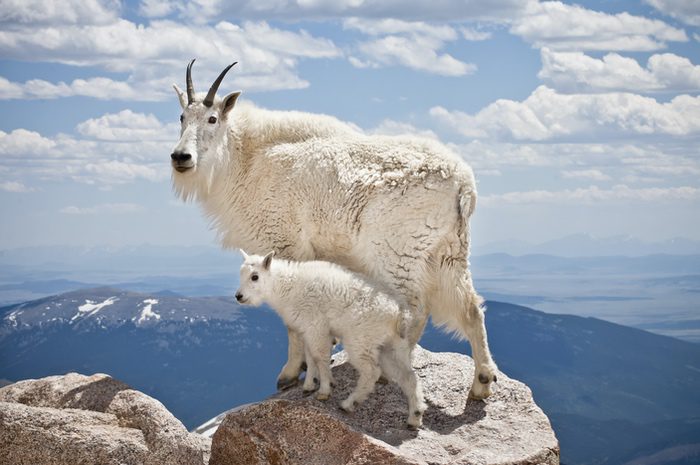
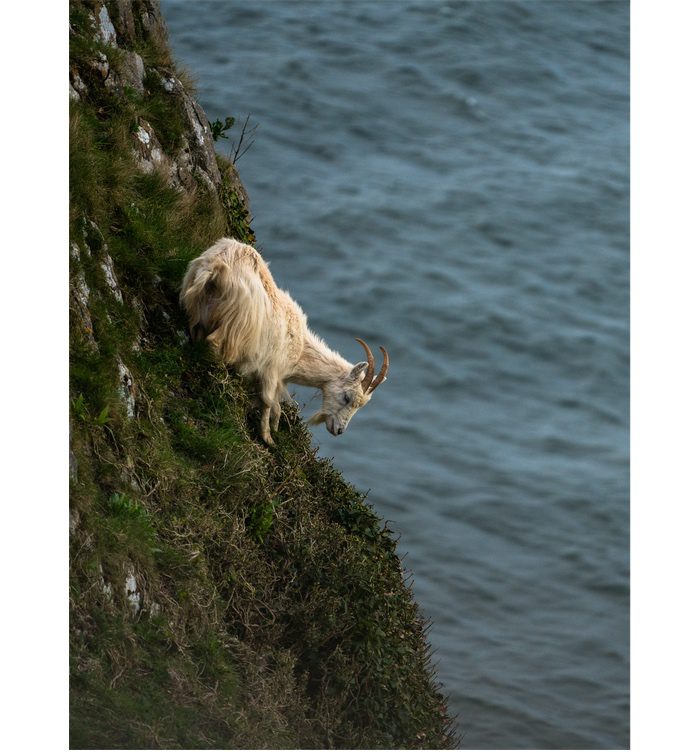
If you’ve ever seen photos of goats scaling a near-vertical mountain slope, you know how sure-footed they are. In fact, seeing a hoofed animal succeeding at such a feat defies the imagination. How does the goat do it? A winning combination of cloven hooves, four-wheel drive, and practice.
As a symbol of sure-footedness, the goat exemplifies the adage – Slow and steady wins the race. If a goat suddenly comes into your life, it can be a sign for you to slow things down, watch your step, and be more in the moment.
Mountain climbers, rock climbers, and even artists often speak about how focused they become when they’re engaged in their task. It’s as if the world falls away and they are in the zone. In essence, this is what the Buddhist philosophy of mindfulness is all about.
The goat reminds you to focus on each step of your journey instead of only fixating on the destination.
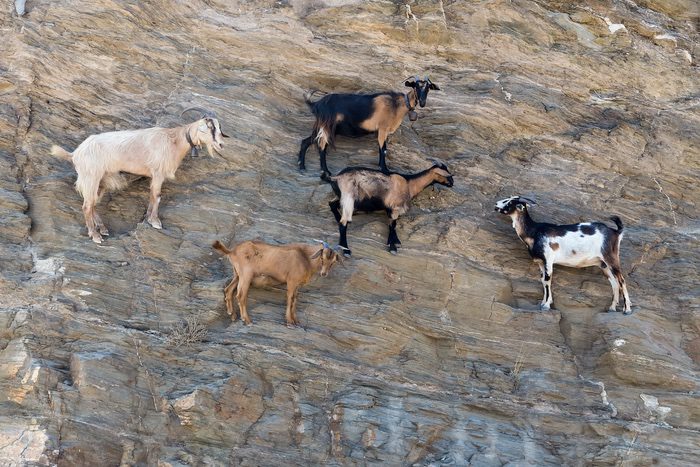
Throughout history, the goat has been associated with virility, fertility, and sexuality – even lasciviousness and lust. How the goat developed this reputation is probably as simple as the fact that goats were the first domesticated animals and people were around them more than other animals.
Goats can start having kids at a young age, so this may have led to their reputation as being lusty. However, they are not as prolific as rabbits. Some historians say the goat’s perpetual desire to seek out greener pastures for grazing may have also contributed to their reputation for being insatiable lovers. Regardless, it’s fair to say that the goat’s reputation is more reflective of the way the human mind works than the goat’s.
Over time, goats came to be linked to deities who were associated with love, lust, and fertility. Notably, these included the Greek gods Bacchus and Aphrodite, the Roman gods Dionysus and Venus, and the Celtic god Cernunnos.
At a fundamental level, sexuality is rooted in desire and primal energy. And desire, fueled by primal energy, can take on many different forms beyond just sexuality. For example, a goat can exhibit a strong desire for a certain outcome – such as wanting to get out of the barn in the morning and then refusing to come in for the evening or wanting that little scrub of vegetation on a dangerously steep mountainside. Once the goat’s mind is made up, It can be difficult to change it.
So, the goat reminds us that desire can have both positive and negative consequences. On the one hand, it can be an incredibly powerful motivating force. On the other, it can be destructive. As the Buddhists say – attachment leads to suffering.
If a goat makes themselves known to you, or if you already know the goat is your spirit animal, it can be a sign to re-examine those things that you want. Often we want things, situations, or even people because of the way they stimulate us in some way. The goat asks: Is that which you desire a healthy attachment? Can you get that stimulation in a healthier way, or do you really need it?
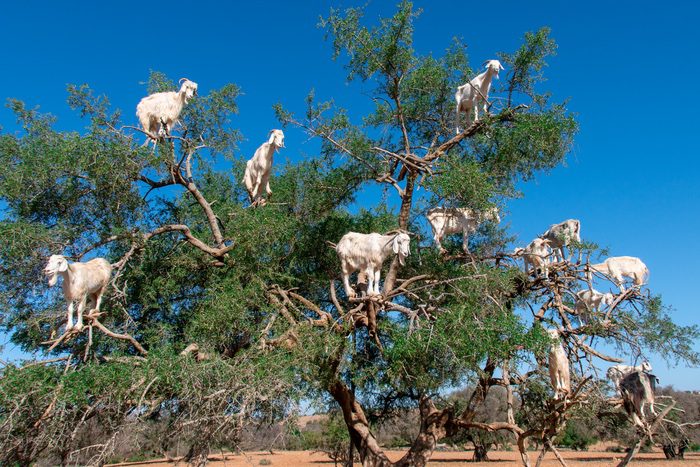
Just as the goat symbolizes fertility, virility, and desire, they also symbolize creative energy. After all, desire fuels our ability to tap into our imaginations and create – whether it’s a piece of art, a new outcome, or even a new state of mind.
The goat is willing to put in the energy required to scale a mountain to escape predators or to find greener pastures. So, as a symbol of creative energy, the goat reminds you that honing your skills and practicing will enable you to be an even more adept creator.
If you’ve ever watched viral videos of baby goats on social media, you know that goats like to have a good time. In fact, calling young goats “kids” is the perfect name for these animals because most goats are kids at heart.
To underscore this point, here’s a video of goats jumping on trampolines:
Another interesting fact about goats is that although they’ve been domesticated for thousands of years, they will readily go feral and live off the land if given the opportunity. In fact, in places like Australia where goats are not native, there is a feral goat problem because of the number of domesticated goats who’ve gone wild.
It’s no coincidence that the goat is linked to deities known for partying, including
Bacchus, Dionysus, and Cernunnos.
Thus, if a goat enters your life, or if the goat is already one of your spirit animals, it can be a reminder that you need to have a little more fun, maybe even throw a party. Life isn’t all about work and responsibilities. The goat reminds you that you can throw a party anywhere and that laughter is free.
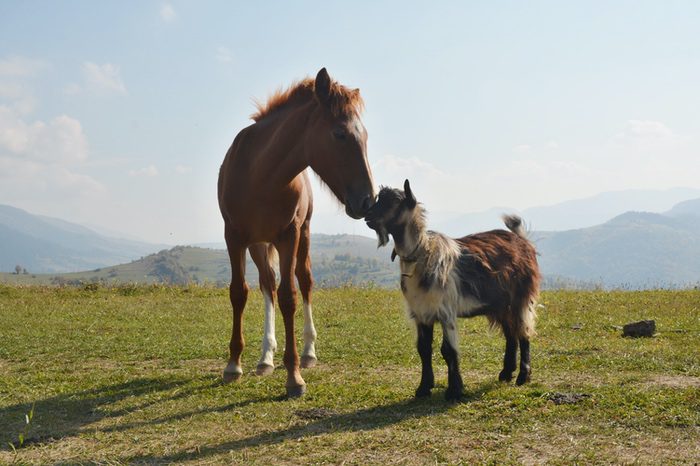
You may have heard the idiom, “Who got your goat?” – which is asked of someone who is annoyed or upset. However, many people aren’t familiar with where the saying comes from. In fact, it was first coined in the world of horse racing.
People who have horses know that the presence of a goat can have a calming effect on them. This could be that the horse views the goat as if they were a foal or perhaps the horse just likes having a little buddy by their side. Whatever the reason, goats calm horses down.
So, in the old days of horse racing, trainers would put a goat in the stall with a thoroughbred before a race to calm the horse down. However, unscrupulous competitors were known to sneak into the stall and take the goat out to intentionally stress out the thoroughbred. Hence, the meaning of the saying – Who got your goat?1
In addition to having a soothing effect on horses, goats embody a bucolic lifestyle. Scenes of green fields in a quiet countryside with goats and sheep tend to calm humans down too.
When the goat is your spirit animal, you’re the type of person who has a calming effect on others. You can find order when there is chaos and serenity when there is stress. In addition, you’re the type of person who can be relied on when the world is going crazy. This capacity to not get caught up in madness is a gift that is yours to express in the world.

Ibexes in the Alps are known to climb to 14,800 feet (4,511 meters) and mountain goats in the Rockies and tahrs in the Himalayas are known to climb to 16,000 feet (4,877 meters).2
This willingness to climb to heights that other animals will not is why the goat is a symbol of ambition and aspiration. Quite simply: the goat aims high.
Goats are also hierarchical animals. A herd queen will lead the herd of goats while bucks will battle for dominance to be the male leader. Thus, goat people are the types who are adept at climbing the corporate ladder or who always up their personal ante. They have the desire to constantly improve and go beyond where they have been before.
In this way, the goat shares symbolism with the alpine flower the columbine. Both grow and thrive at high elevations. The goat reminds you to always reach for the stars.
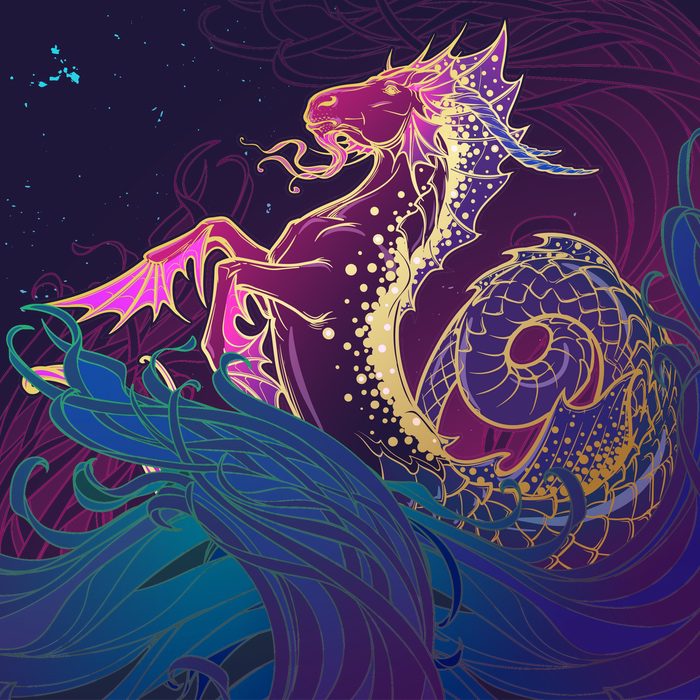
The zodiacal sign of Capricorn is represented by a half-goat, half-fish. This is because Capricorns are known to be the most ambitious signs in the zodiac. The symbol for Capricorn represents the sign’s desire to ascend and evolve – from fish to mountain goat.
The acronym G.O.A.T. is very much in line with the goat as a symbol for aspiration. G.O.A.T. stands for “greatest of all time” and it was first coined for professional athletes who were the best in their class – those people who always pushed the envelope to be better and better at they do.3
As a symbol of aspiration, the goat is a powerful reminder that you can achieve more than you think you can. As Oprah Winfrey always says, the Universe has plans for you that are beyond your wildest expectations.
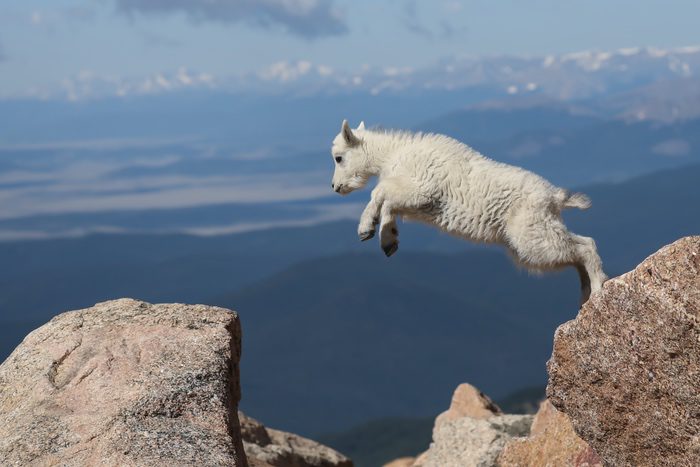
As the mountain goat seeks higher elevations, they are also symbols of faith. The sure-footed goat can scale a nearly-vertical incline with the confidence that they won’t fall.
Hence, the mantra of the mountain goat is: “Faith not fear.”
In this way the goat reminds you that your Angels are on your side. This may be in ways that you don’t understand now, but in the future you will.
Like the stag’s antlers, the goat’s horns are also a symbol of spiritual ascension. Their horns are like antennae taking in information from the spirit world. Goats don’t shed their horns. So, like the rings on a tree, the rings on the goat’s horns are an easy way to determine their age. Hence, a mature goat symbolizes a higher level of spiritual enlightenment.
When you tune into the world that is beyond this one, you have a sense of the bigger picture of your existence. Your body is just a vehicle to help you learn as you navigate your soul’s journey here on Earth. The goat reminds you to have faith that challenges you face can be used to help you become a more enlightened soul.
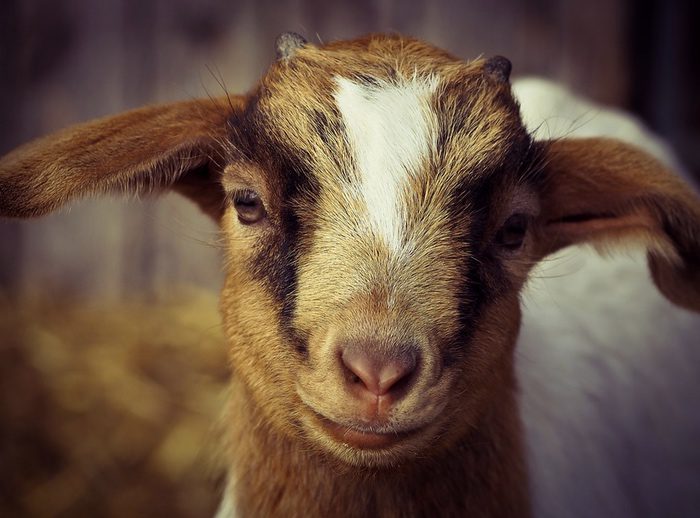
Goats have lived with people since at least 8000 BC and they inhabit nearly every continent.4 So they are important figures in the mythology and folklore of many cultures. Here are some of those stories:
In the cradle of civilization, the ancient Sumerians had a creator god named Enki or Ea. He was sometimes depicted as half-goat and half-fish. Enki ruled water, mischief, and creativity.5
In ancient Egypt, goats symbolized fertility and creativity. The ancient Egyptians had a protector god named Khnum who was depicted as part-human and part-goat or par-ram. Like Enki, Khnum was also associated with creativity. The ancient Egyptians believed he created the Nile River and that he crafted human children from clay.6
Khnum’s counterpart in Lower Egypt was a deity named Banebdjedet. He also had a goat or ram head. Banebdjedet and his goddess wife Hatmehit gave birth to the falcon-headed god Horus.7
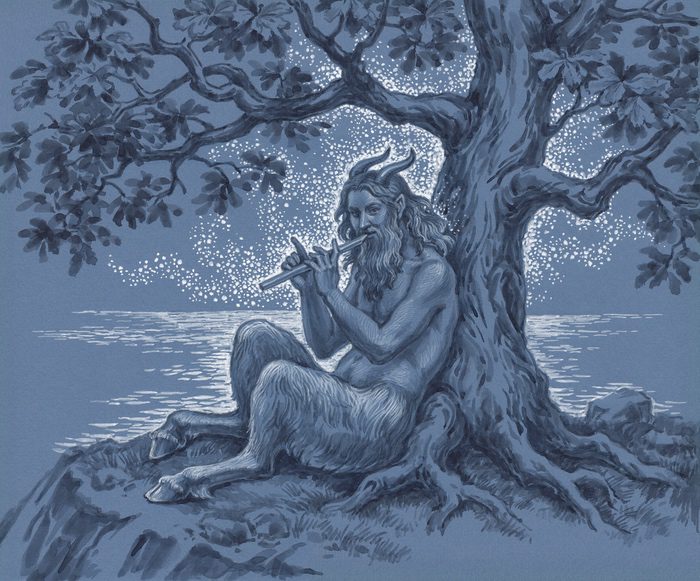
The goat is a very important figure in Greek and Roman mythology. In fact, much of the later cultural views of goats, including those in Judaism and Christianity, likely had roots in Greek mythology.
As mentioned earlier, Bacchus, the Greek god of partying, and his Roman counterpart, Dionysus, were associated with goats. In fact, they allegedly drank wine as they rode chariots pulled by goats with cherubs fluttering overhead.
The top Greek god, Zeus, was said to have been nursed by the goddess Amalthea in a cave on Mount Aigaion. The name of the mountain translates to Goat Mountain. Amalthea is sometimes portrayed as goat, and at other times as a nymph who is tended to by goats.8
Furthermore, the Greek and Roman goddesses of wild animals and hunting, Artemis and Diana respectively, were depicted as accompanied by goats.
One of the most famous Greek goat deities was the god Pan. Like his Roman counterpart, Faunus, Pan was a lusty, flute-playing partier who had the horns, ears, and legs of a goat.
Satyrs were Greek nature spirits who were originally depicted as having the body of a man and the back legs of a horse. However, over time, they came to resemble Pan more closely, with the body of a man and the horns, ears, and legs of a goat. Like Pan, the satyrs were also partiers. They loved wine, music, and women. Undoubtedly, they are where the term “horny” comes from.
Fauns were nature spirits in Roman mythology who were similar to satyrs in terms of looks but were a little tamer.9They were named for the god Faunus, who was the deity of forests, fields, and herd animals.
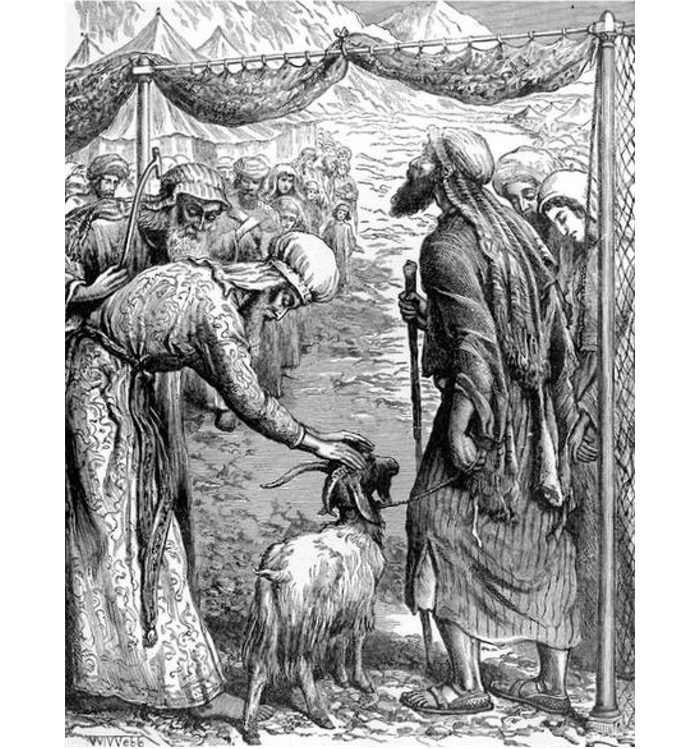
In biblical times, even the poorest of families had a goat, which was used as a source of milk.10 The goat was so important that families would bring the goat inside the home for protection and extra warmth. Goats were a part of everyday life and they are mentioned throughout the Bible.
Although people relied on their goats, they didn’t always view them with kindness. For one, goats were used often in religious sacrifices. And the Old Testament has the first reference to goats as satanic beings.
Isaiah 13:21 references satyrs or se’īrīm, which were viewed as goat demons.11 (Sa’ir is the Hebrew word for “he-goat.”) Thus, the goat was associated with lewdness and even worshiping false gods.12
This view carried through to Christianity, where the goat came to be associated with paganism, lust, lewdness, and the devil. (By comparison, sheep symbolized the God-fearing faithful being led by Jesus or God as their shepherd.)
The practice of sacrificing goats dates back thousands of years. And the first example of a scapegoat dates to 2400 BC in what is now Syria. According to the strange tradition, a pair of goats was selected. One was sacrificed and the other was released into the wild. The latter was the scapegoat, or the goat who escapes.13
However, the scapegoat didn’t totally escape. He was burdened with the people’s issues: their sins, impurities, and other negative behaviors and thoughts.
In the Bible, the scapegoat story first appears in Leviticus 16:8-10. The scapegoat was sent into the wilderness to appease Azazel, an evil spirit, while the other goat was sacrificed to appease God.14
Over time, the scapegoat came to represent Christ, who died on the cross for people’s sins.
By the time of the crusades in the 11th century, a new goat demon appeared in Christianity called Baphomet. The French knight Anselm of Ribemont wrote a letter in 1098 that described the Siege of Antioch during the First Crusade. He noted in his letter that the Turks “called loudly upon Baphomet,” whom he assumed was a demon.
The terror on the part of the European crusaders who were in what they viewed as their Holy Land hearing the strange tongue of people whom they viewed as pagan enemies is understandable.
On the flip side, we can imagine the horror on the part of the Turks facing foreign invaders who were infidels in their Holy Land.
Modern-day historians and religious scholars believe that when the crusaders heard what they thought was the devil’s name of Baphomet was actually the Turks yelling their holy prophet’s name – Muhammad.15
Despite the misunderstanding, Baphomet’s reputation endured for the next few centuries. By the 14th century, King Phillip IV of France was feeling that his power was being usurped by the order of knights called the Knight Templar. So, King Phillip had many of them rounded up, tortured, and killed. According to King Philip’s inquisitors, under torture, some of the Templars confessed to worshiping Baphomet.16
By the 13th century, the French began adorning cathedrals and other buildings with demon-like creatures that would supposedly scare other demons away.17 Called grotesques and gargoyles (the latter being the ones who gargle or spit water), the monsters took on a variety of animal-ish, human-ish, and monster-ish forms. Notably, on Notre-Dame there are some with goat horns and heads.18
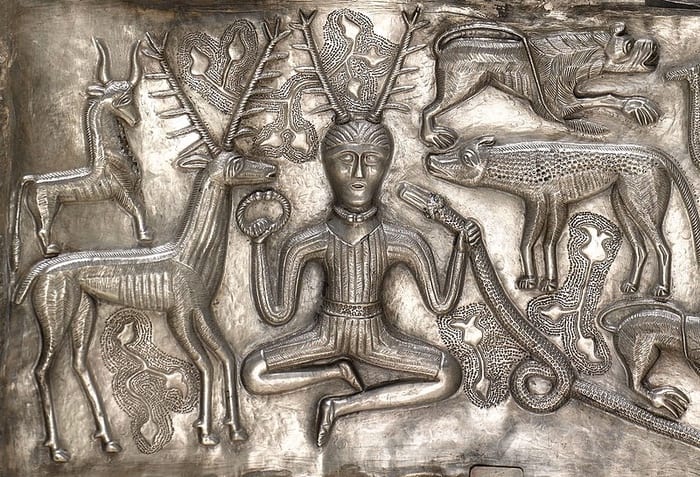
Like other cultures, the Celts viewed the goat as a symbol of fertility and virility. They depicted their god Cernunnos with horns or antlers as he was associated with goats, stags, and deer. Cernunnos was the Celtic god of nature, the forest, wild animals, and abundance.
The Celts also told stories of the glaistig, who was a fairy who took on the form of a beautiful woman who was half goat. She would lure men by offering sexual favors. Then once they were under her spell, she would kill them and suck their blood.19
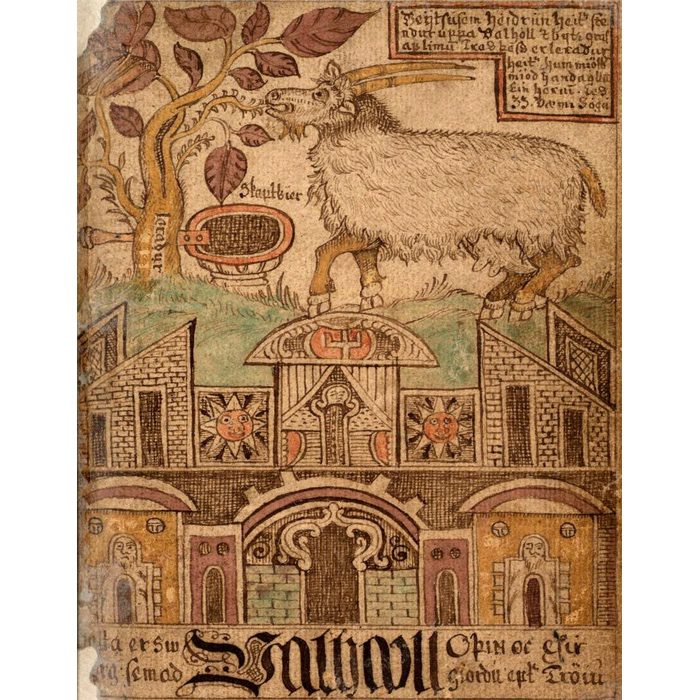
The goat is an important figure in Norse mythology as well. To begin, there is the mythical goat named Heidrun.
According to legend, Heidrun munched on the leaves of the Yggdrasil Tree, which is the Nordic Tree of Life. And when she is milked, mead came out, which the gods feast on.20
In another Nordic legend, Thor had two goats named Tanngrisnir and Tanngnjostr who pulled his chariot.
According to the legend, Thor found Tanngrisnir and Tanngnjostr when he traveled with the god Loki to Midgard, where humans live. Feeling hungry, the two gods stopped at a farm where a poor farmer and his wife lived. The farmer and his wife knew they would never be able to feed the two gods to their satisfaction, so they offered them their only two goats.
Thor took the goats and said that everyone would be able to partake in the feast. However, he said that they could only eat on the condition that they didn’t break any of the goats’ bones and that when they were done, they would put the bone on the goats’ fur. After the meal, everyone fell asleep. The next morning, the farmer and his wife got up to find their goats were alive and well again.21
The Scandinavians also have a tradition called the Yule Goat. According to the story, at Yule time, Father Christmas rides in on a white goat carrying presents.22
For many western Native American tribes, mountain goats were an important food source. Some tribes, including the Hopi of the Southwest and the Haida of the Pacific Northwest, even have goat clans.
For the Chilkat Tlingit People of Alaska, the mountain goat is a sacred animal. They weave mountain goat hair into their blankets and other textiles.23
The Syilx People, who are from what is now the state of Washington and British Columbia, have a legend about how they got huckleberries.
Once upon a time, many animals were courting the beautiful maiden named Eagle. One suitor in particular was the Mountain Goat. However, Eagle found him and his family to be crude and vulgar and she told them so.
Eagle’s family knew she should marry, so they decided to hold a running race among the animals. The winner would earn her hand.
Mountain Goat approached Eagle and told her that he would win the race. Eagle just rolled her eyes and walked away. Feeling despondent at the rejection, Mountain Goat sat on the ground, not feeling like running. However, his brothers came to lift his spirits and they planted a huckleberry bush where he sat. Mountain Goat ate some of the berries and was soon restored.
All of the animals lined up to race. The chief yelled, “Go!” and they were off.
Mountain Goat was not the fastest. However, when the runners reached the mountain, they were terrified. There was snow at the top and many steep cliffs. Some attempted to scale the mountain and fell back down, while others did not even try.
However, Mountain Goat was not deterred. Slow and steady, he scaled the mountain with grace, reaching all the way to the summit. Eagle watched from the ground, noticing how his fur turned glowing white when he reached the snow.
When Mountain Goat and the other animals returned to the village, Eagle was so impressed that she agreed to marry him. The other animals were also impressed with the Mountain Goat. They were so in awe of him that they even tried some of his huckleberries. And this is how the people first got huckleberries.24
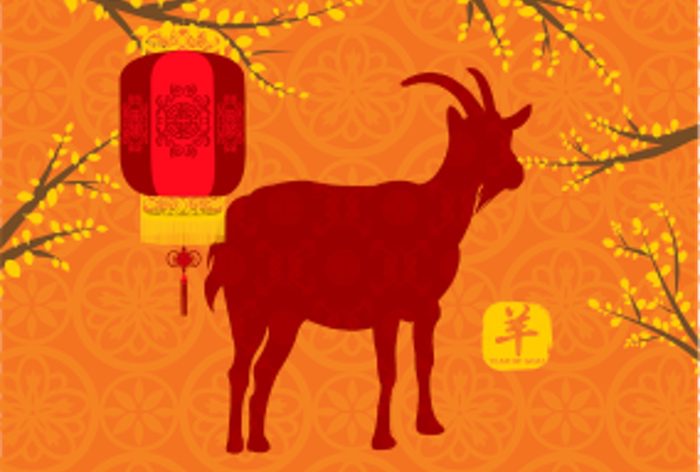
The Chinese tell stories of Yang Ching, a goat spirit who protects people from wild animals. He resembles a satyr in that he has goat ears, horns, and legs. As in Greek and Roman mythology, in China, Yang Ching and other goats are associated with revelry and merrymaking.
The Chinese have another mythical goat who is called Xie Zhi who is described as having one horn like a unicorn.
The goat is considered a lucky animal in China. For example, in Chinese astrology, the goat is the eighth animal in the zodiac. And in China, the number 8 is associated with growth and prosperity.25
In the Chinese zodiac, people born in the Year of the Goat are said to be gentle and mild-mannered. However, their gentleness can be misleading as they are actually very tough under their soft exteriors. They can persevere in times of difficulty due to their high levels of motivation.
Goat people are also said to be creative. They enjoy learning new skills to become better at what they do. The one negative about their personalities is that they can be very stubborn.
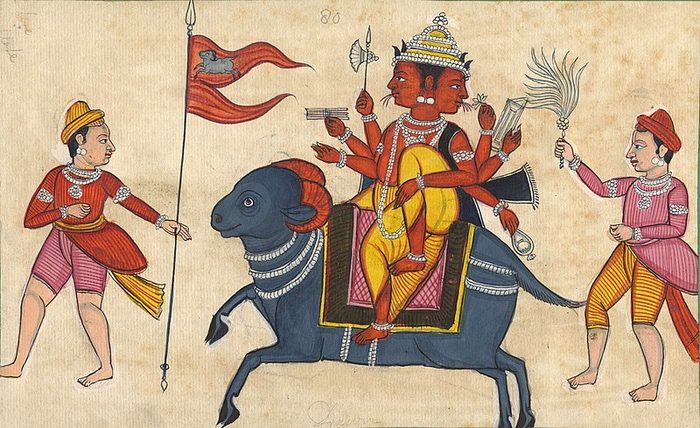
Like Thor in Norse mythology, in Hinduism, the Vedic god of fire, Agni, rides a chariot that’s pulled by goats. Another Hindu deity, Kali, who is the goddess of doomsday and death, is said to ride a black goat. Consequently, in earlier religious practices, devotees would sacrifice white and black goats in honor of these deities.
The Hindus have a few other goat deities. Naigamesha is a goat-headed (or deer-headed) deity who is a fertility god and protector of children. Hence, Hindus would pray to and honor him if they wanted to conceive and also for protection of their existing children.26
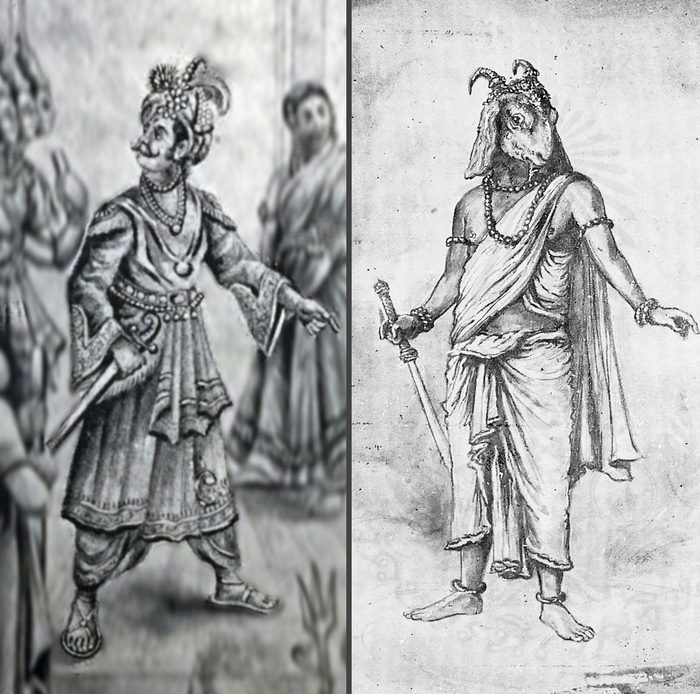
In one Hindu creation story, there is a deity named Daksha who has many daughters. Daksha decided to hold a fire sacrifice. However, he did not invite his daughter, the goddess Sati, or her husband, the god Shiva. The fierce god Virabhadra was so offended by this slight that he killed Daksha by cutting off his head. However, Daksha was resurrected, only with the head of a goat.27
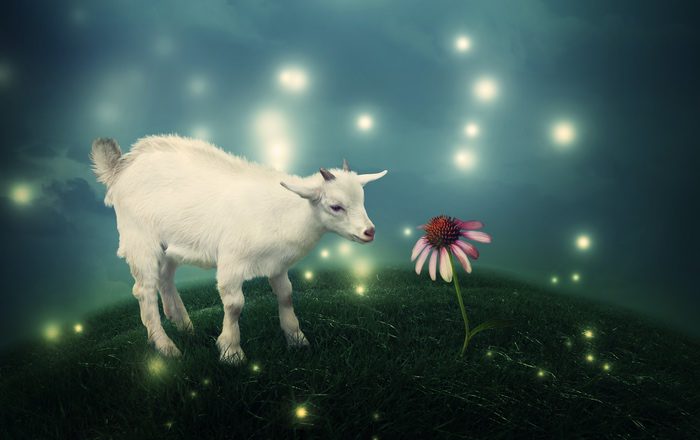
When the goat is your spirit animal, you have a steady guardian on your side. If a goat makes themselves known to you in a way that rivets your attention – take note. There are no coincidences. The goat can provide insights to you as you navigate your life path here on Earth.
Goat people can tap into the positive qualities of the goat spirit animal. As you aspire for better outcomes and new opportunities, you’ll be steady and sure-footed in your approach. You can also tap into the creative energy embodied by the goat to manifest the outcomes you envision.
The goat spirit animal also reminds you to never lose your faith. Your angels are present and working behind the scenes to help you. Believe.
If you’re curious about other spirit animals who might also be your guides, you can take UniGuide’s spirit animal test.
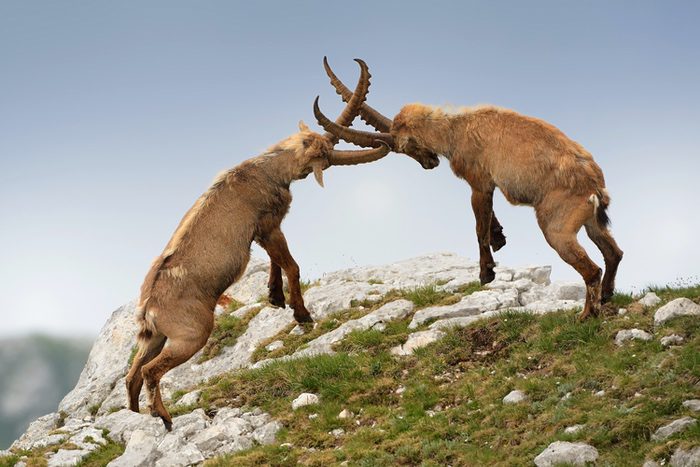
As the name implies, a power animal can empower you with their most dynamic traits. So, if you want to transform an area of your life, consider the attributes that the power animal represents. For example, you can meditate on the goat power animal in a situation where you:
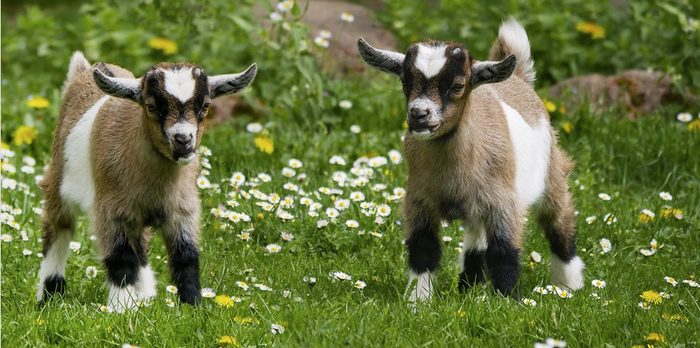
An animal totem embodies the protective powers of the animal it represents. Thus, the goat totem serves as a helpful symbol for manifesting what you would like to happen in your life. The practical goat reminds you that with perseverance, you can achieve your dreams. The goat totem is also a good luck talisman for tapping into creative solutions to overcome challenges. In addition, a mountain goat totem can remind you that faith will always overcome fear.
What does it mean if you dream of a goat, mountain goat, or herd of goats? Dreams can have a range of meanings and they are unique to the dreamer. So, there is not one cut and dry answer as to what a goat dream means. Sometimes dreams are our mind’s way of processing leftover thoughts from the day. Or they can be the mind’s way of creating a pleasant experience to soothe us. Fearful or anxious dreams can be a wake-up call to address something in our subconscious that we’ve been avoiding. Furthermore, dreams can also be messages from spirit guides and other souls.
When it comes to understanding the meaning of your goat dream, it’s important to consider the way you view goats and the emotions you experienced in the dream. This can provide insights into what the dream is telling you.
Hopefully learning more about goat symbolism and mythology can shed some light on what your dream is telling you. For example, it could mean you long for greener pastures or new experiences. Or it might mean you need to tap into your creative energy more. All dreams are a blessing.
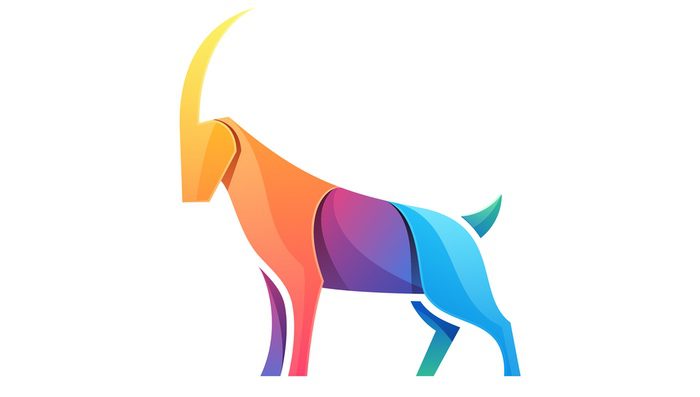
A goat tattoo is a positive symbol that shows the world that you’re the type of person who aims for the stars. It can also demonstrate that you’re not afraid of working hard to achieve your dreams. A mountain goat tattoo can be a symbol of your faith in a higher power or even in yourself. Of course, a goat tattoo can also demonstrate that you like to party!
Tattoo meanings are deeply personal to the person whose skin they adorn. However, hopefully understanding more about goat symbolism and mythology can bring deeper meaning to your tattoo.
As is the case with so many other wild animals we share our planet with, most wild goat species, including mountain goats, are considered vulnerable or threatened by the International Union for Conservation of Nature (IUCN). Threats that wild goats face include hunting and poaching, habitat loss and degradation due to logging and mining, and competition from domesticated livestock.28
While domesticated goats are plentiful, they are unfortunately viewed by most people as property instead of the sentient beings that they are. Anytime a sentient being, whether a human being or an animal, is viewed as a piece of property, they are vulnerable to abuse. Goats are used by humans for their milk, meat, and their coats, so they are vulnerable to exploitation.
If you care about goats and their welfare, please do what you can to protect them. Here are some organizations that work on goat protection and conservation:
UniGuide is dedicated to nature and animal lovers, spiritual seekers, and mythology fans.
©2025 UniGuide Media LLC
All Rights Reserved.
UniGuide participates in affiliate programs in which I may earn a small commission if you buy products you link to from UniGuide. Please see my Disclosures for details.
I donate 10% of UniGuide’s profits to animal welfare, wildlife conservation, and environmental charities. Learn more on About UniGuide.
UniGuide Media LLC
Sausalito, CA 94965
| Cookie | Duration | Description |
|---|---|---|
| cookielawinfo-checkbox-analytics | 11 months | This cookie is set by GDPR Cookie Consent plugin. The cookie is used to store the user consent for the cookies in the category "Analytics". |
| cookielawinfo-checkbox-functional | 11 months | The cookie is set by GDPR cookie consent to record the user consent for the cookies in the category "Functional". |
| cookielawinfo-checkbox-necessary | 11 months | This cookie is set by GDPR Cookie Consent plugin. The cookies is used to store the user consent for the cookies in the category "Necessary". |
| cookielawinfo-checkbox-others | 11 months | This cookie is set by GDPR Cookie Consent plugin. The cookie is used to store the user consent for the cookies in the category "Other. |
| cookielawinfo-checkbox-performance | 11 months | This cookie is set by GDPR Cookie Consent plugin. The cookie is used to store the user consent for the cookies in the category "Performance". |
| viewed_cookie_policy | 11 months | The cookie is set by the GDPR Cookie Consent plugin and is used to store whether or not user has consented to the use of cookies. It does not store any personal data. |
2 Responses
So interesting and informative.thank you. I’ve discovered the goat 🐐 is my spirit animal and Im delighted! Makes a lot of sense. I can now focus on connecting more with my goat
I am happy to heart this!